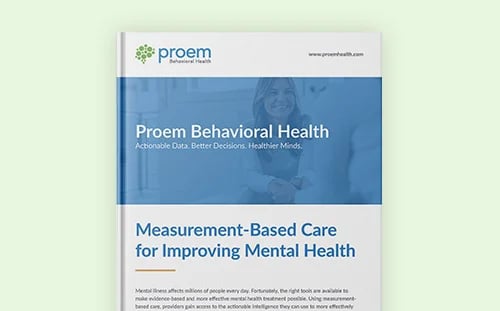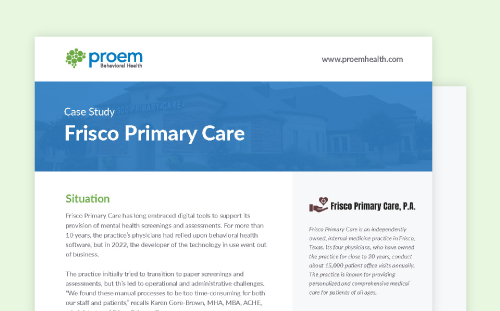Patient management in mental health is often quite challenging. While clinicians in other areas of medicine have endless objective data points, from lab results to vital signs, mental health providers must rely on mental health screening tools to objectively manage their patients. While physical and mental health differs here, one area they have in common concerns the use of multiple data points. Just as there is a good reason multiple lab studies and diagnostic tests are typically used to investigate a litany of disease states, it is wise to deploy mental health screening tools to gain a better understanding of mental disorders. Let's explore why.
Comprehensive mental health screening tools can lead to a more accurate diagnosis.
One in five people in the U.S. are experiencing a mental illness. We saw how the COVID-19 pandemic shone a light on mental health challenges and, in some cases, exacerbated existing conditions. Incorporating mental health screening tools could be part of the solution for the millions of adults and children walking around with undiagnosed and incorrectly diagnosed mental health conditions.
Early in the treatment of mental illness, clinicians should leverage comprehensive screening tools. Since these tools are often brief and focus on specific mental health symptoms, they can allow providers to identify high-risk patients and develop further, more targeted mental health assessment and treatment strategies. Plus, the nature of screening tools allows them to be used quickly during routine office visits and administered by support staff or even self-administered by the patient. Providing mental health screening online through in-office electronic devices is another method for streamlining the process. This ease of use allows clinicians more time to focus on their patients, which can lead to better outcomes, greater patient satisfaction, and more patients receiving support and treatment.
A comprehensive approach to mental health that uses validated screening tools, and in a regular manner, allows a clinician to better identify the correct DSM-5 diagnosis, ultimately enables clinicians to provide the best, most personalized care. For example, let’s consider some commonly used tools: the cognitive therapy rating scale (CTRS), the patient health questionnaire-9 (PHQ9), and the Sheehan Suicidality Tracking Scale (S-STS). Used in isolation, these tools can serve a purpose, respectively, in identifying a patient’s competence for cognitive therapy, investigating depressive symptoms, and assessing suicidality. When used in combination, they provide a clinician with a more complete picture, useful for identifying how therapy is impacting the levels of suicidality or depressive symptoms. By using such tools together, clinicians might even begin to see if a condition is evolving. If providers were to layer on additional screening tools, like the mood disorder questionnaire (MDQ) or drinking motives questionnaire, they could potentially gather even more data points to inform diagnoses and treatment.
Clinicians can better understand and track symptom severity with the right mental health screening tools.
When patients are diagnosed with essential hypertension, a typical course of treatment is to prescribe anti-hypertensives and have the patient receive ongoing blood pressure monitoring. The blood pressure measurement after a course of medication is objective data that the clinician uses to titrate medications and make treatment decisions.
Mental health screening tools can be used in a similar fashion. Following a defined period after the completion of an assessment, screening tools can be used to more objectively track patients’ core symptoms. The objective data gained from screening tools can be used in conjunction with mental health assessments to further develop and strengthen a patient-specific treatment approach.
Mental health screening tools are often population-specific, so understanding your options is important to mitigating bias.
New mental health screening tools are constantly being developed and evaluated. Typically, years of patient interviews are followed longitudinally with their mental health outcomes to identify how a screening tool holds up against the test of time and patient volume. Since all patients are different, it makes sense that screening tools should also be different. Just as mental health screening tools for adults should be different from ones used for children, screening tools must be selected with the individual in mind. In other words, they should be selected and tailored to the demographics and specific life circumstances of the patient.
Body dysmorphic disorder is a pragmatic example of why population-specific screening tools should be used. Two different screening tools could be used for this mental health disorder: the body dysmorphic questionnaire (BDDQ) or the body image disturbance questionnaire (BIDQ). Research shows that the BDDQ is a much more sensitive and specific test for the diagnosis of BDD in psychiatric, cosmetic surgery, and dermatology patients. This is a more accurate screening tool for these patient populations.
The BIDQ, on the other hand, is a slightly modified self-report version of the BDDQ that uses continuous response scaling. While BIDQ has strong psychometric properties in a non-clinical population, sensitivity and specificity data are needed. The BIDQ does not have as much data to support its clinical use, but it does represent a good screening tool to identify those who may be at higher risk of body dysmorphic disorder.
When choosing which mental health screening tools to use, consider who the screening tools were developed and are intended for.
Using the right mental health screening tools can get patients the right care faster.
Patients may not be forthcoming about their symptoms when talking with their physician. This can make screening tools essential to supporting early detection and subsequent early treatment. A positive screen does not mean the patient is diagnosed with that mental health condition. Rather, it represents that the patient requires further assessment to determine the appropriate course of action. Using the appropriate mix of screening tools or a comprehensive screener like the Mini International Neuropsychiatric Interview (M.I.N.I.) Screener, is more likely to yield accurate reporting because a more comprehensive picture can yield better insight into the most appropriate next steps for achieving an accurate diagnosis and building an appropriate treatment plan.
Often, mental health patients lack the insight, judgment, or comfort necessary to openly discuss their problems, making comprehensive mental health screening tools impactful in helping uncover the issues they are facing. Earlier treatment typically leads to less dysfunction and a more favorable prognosis. The quicker patients can receive proper care, the less likely it is that they will develop compounding mental health issues, such as a primary mental health disorder with a substance abuse disorder. For SUD patients, for example, comorbidity is common. Research indicates that about half of those who experience a mental illness will also experience a SUD and vice versa.
Accessing the Best Mental Health Screening Tools
Proem has assembled the most cohesive set of evidence-based behavioral health tools, including the comprehensive M.I.N.I., and made them available through a single, modern platform powered by an intelligent workflow engine. Learn more about the behavioral health scales and measurements incorporated into the Proem solution.





.png)










